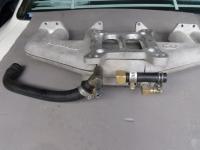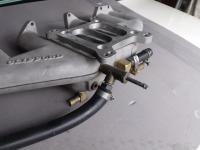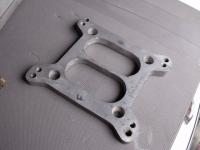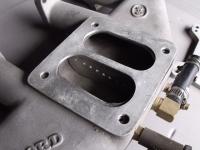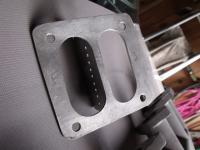Everything posted by ozconnection
-
New engine
Hi Guy, Sounds like a great combo of parts there buddy. Should be a very nice revver. Please don't put a stock damper and flywheel on the beast will you? The L24 revs well because of the rod to stroke ratio as you're aware. I've just screwed together my new L28 and thought long and hard about those sorts of details so that's why I had custom rods built to suit my JE forged 300ZXTT pistons. Now I have an L28 with a 1.72 rod to stroke ratio (and a bit closer to your much better 1.8 than the original L28's 1.64). All the best mate. Let us know how it all progresses. :classic: Cheers. Ps I have an L20A crank and spare N42 block and......:bulb:
-
Playing with a wideband
I would love to know how you got your engine to idle at 17.5:1 AFR??? If I tried that with mine, it would be spluttering and nah it would stall. Go and listen to your exhaust and tell me how smooth its running. If it sounds like mmmmpmmpmmmpmpmpppmmmm then it's lean, probably too lean, well, too lean for me and my setup anyway. I run around 12.5 AFR in my Datsun when it's up to running temperature. I'm curious about your setup because what you run is so far away from what works on my L28. Cheers.
-
MSD Street Fire CDI
Hey, that's great news. Any pics? (I run MSD 6AL on my L28's. Does the Street Fire unit replace the 6AL?)
-
New head gasket
I have the most valuable hint you'll ever hear: If the idea of changing a head gasket is too much pain (for you), pay someone else to do it!
-
Cam and Ignition timing issues?
Zed head has all the best tricks!! Well done mate, perfecto. Best part is it works.
-
Playing with a wideband
Yeah, thanks for the clarification, I learnt something too LeonV, cheers mate. :classic:
-
Playing with a wideband
Hell, any induction setup can give the wrong mixtures to the engine if not calibrated correctly!! That's where the time factor comes in. How anal are you to get it as close to perfect as possible? That is often the criticism of any setup, especially non factory carb setups. You can get them very close to spot on but sometimes it can take more time to do it than most people are prepared to spend and that's what gives 'them' a bad wrap. 16 to one mixtures are not too unreasonable. If the throttle is barely cracked open and the cylinders are hardly filling with each cycle of engine rotation, no real damage will occur at this point. At WOT and 16 to one, kiss your engine goodbye. Is there surging at 75mph and 16's?? Surging represents unstable or erratic combustion ie missfire. Too much advance with this lean mixture can cause surge so you can look at that scenario as well. Yes, good question and Madkaw just asked it as well. Is your vacuum advance hooked up? I found that my running consistancy was all over the place with the extra 12 or so degees added with the vacuum pot on the dizzy. I now run my dizzy without vacuum advance. If the engine sat all day at 3k rpm and never climbed a hill or changed speed, I'd continue to use a vacuum advance pot. cheers.
-
Cam and Ignition timing issues?
I'm glad you wrote this Zed Head, saved me from doing it! You want race this car. Your not ready. The timing issue bothers me and that absolutely needs sorting from two aspects. 1) If your timing is that far advanced, it will hammer the rings, pistons and bearings and something will give...usually the ring lands but anything is possible. Just because you can't hear pinging doesn't mean its not happening. There is no latitude either, get a stale batch of fuel or fill up somewhere else and it could spell engine expiry quickly. Back off the ignition timing to something sensible until YOU PROPERLY VERIFY what's going on. 2) If the outer ring on your balancer is lose, then racing the engine or spinning it with high revs means that the dampening effect will be greatly diminished and crank breakage is a real possibility. Take your balancer off, inspect it, check the keyways are aligned with the vertical centreline of your engine and ditch it with something better. Even a reco stocker is better than a suspect original. Change your chain whilst you're at it and even your guides. Spend hundreds now or thousands later, your call.
-
Cam and Ignition timing issues?
Fresh build with 90K? Huh?? Do you mean just the head has been freshened up? Did you talk to the Z mechanic after the instal to ask him what your asking here? What did he say? Did he suggest a new timing chain? Does your head have new valve springs? Sounds like a nice combination of parts. If you put all this together yourself, then you should know that you can't advance your timing that far and expect good results. Bang it up to 30 degrees mate, if 25 is good, more is better right?....WRONG! Total mechanical advance for your combination if the compression is stockish and the fuel is the best from the gas station is around 35 degrees. With 25 degrees static, you'll be well over this. Try 15. I can see that you have a wide band. Now spend some more and get a decent timing light like a Innova professional unit that will advise what your timing is versus engine revs on the guns LCD display. New cam? Should've been supplied with a cam card. Who did the instal? Do you have a multiholed cam sprocket or the stock 3 hole jobbie? For the best possible results you should use a better cam sprocket. I don't because I have a stock cam, but I do have one ready for my next engine combo because that engine will have modified parts! Modified cams need a cam card, with a proper cam sprocket and someone who knows what they're doing. Get someone who knows this stuff to help you out the next time you check things out. Take written notes or record it on a camcorder or something. Then you'll be able to refer to your notes later on for whatever reason. Good luck
-
Playing with a wideband
I have an Innovate wide band sensor. Your idle is rich. It gets richer the hotter the engine is right? Mine is 12.5ish HOT! 2 is still too rich, get 13.8-14.8 3 is ok 4 is ok too, mine is closer to 13 than 12 say 12.7-13 5 call in vacuum advance, extended timing tends to show a leaner mixture....so long as you have no surging, your mixtures will be fine. Now the test is to get everything to where you need it. That's where the hours come into it. Ask me! What's your induction setup? Webers, Su's? They're a cool tool.... Tuning for power or economy? Cheers.
-
Pacesetter headers?
If I were to drive for 8 hours a day 5 days a week like a courier or taxi driver, that would be 40 hours. If I drove for 3 weeks like that it would be 120 hours. If I were to travel 18000 miles in that time, I would need to be going 150mph. My experiences are mine. I report back what I know to be true with what I have done with my car. I too have owned and driven this kind of vehicle for 25 years. Your experiences are different to mine and that's cool. Each has their own opinion. And it was an L28S....the same engine I showed you when you were at my place. Behind an auto with an asthmatic Hitatchi 2 barrel on an emissions manifold and pidly exhaust with a stock cam head compression and points ignition. Yes it was 60kw's........maybe the dyno needed recalibration but I always went to the same guy so all testing was consistant from that point. Error is error if its always the same error factored in each time...yes? Take it as relative values compared to absolute then? Thanks Tony for your constructive thoughts. PS Dunno about you guys complaining about the noise, they're friggin sports cars, not Geo Metro's (or Cedrics) and who honestly doesn't love the sound of an inline 6 like ours. Don't you want your hot girlfriend to wear short skirts and an open top if she's "built' for it. c'mon.
-
Pacesetter headers?
You could do a lot worse than buying a set of headers that look like that my friend...... Thanks for the link Mike PS Pacesetter, not Pacemaker, my bad!
-
Pacesetter headers?
I have seen some very nice headers over the years and just as many awful ones. Silly things like welding flash, thin mounting flanges that don't match the thickness of the intake manifolds, poor placement of pipes that don't fit all intake manifolds, poor exit angles, poor merge collectors etc. Do you have any pictures of these pacemaker headers for the L Series 6? Without pictures, it's a hard call to make either way. Unless they're total crap, I still stand by what I said earlier though.
-
Pacesetter headers?
The only bit that I found to be true is that the exhaust is louder than stock but that may also be attributed to my 2.5 inch pipe that followed on from the headers. The stock exhaust manifold is a good thing for what it was originally designed for. Optimising the engines performance in terms of power, they're only average. Talking NA motors, it's important to move the wasted gasses of combustion away from each of the cylinders efficiently because reversion and contamination of the fresh air/fuel mix will take place if we don't. At lower engine speeds the difference between headers and a stock exhaust manifold may not be huge but as the engine revs rise, the gas volumes increase and the time to do this decreases, the benefits of headers are there, even for a "stock" engine. I performed a series of enhancements to a 'stock' L28 a number of years ago and found that what I've just said to be very true. Everything except the carb was stock. I was using a stock P53 intake (single downdraught manifold) with an adapter plate for a 4 barrel Holley carb. Power rose from 60 kw@wheels to 66 Kw@wheels with just the carb upgrade. The exhaust was totally stock. Then I changed the exhaust to headers (6-2-1) and a 2.5 inch pipe and the power rose to 86kw@wheels. Yes, some might argue that the original poster was asking the effects from headers only but I believe that there is a trend here, that the exhaust is just as if not more important than the induction to modify in search of greater performance. The dyno is my proof. Never had any problems with leaking, that's just bad luck or poor installation if they do. Rusting may be an issue where you live ie salt on roads etc but mine have lasted donkies so I;m not worried by that. You can wrap the header pipes with thermal wrap/tape. I did, less noise and slightly more power because the heat is kept in the exhaust and the gasses move more quickly when hot....see how slow they are at the end of the tailpipe after they've had a chance to lose some of their heat!! Do it man and consider it your 1st performance upgrade to your engine.
-
holley setup
I have no experience with those. It could depend on how far up the exhaust the sensor will go as too close to the end of the tailpipe might give false readings. There is no such issue with the innovate style mounting points. Yes, some call it a 3-2-1 but does this make any sense when you actually look at the pipes....six primaries, two secondaries to one tertiary. And some people can't help themselves at all. :disappoin
-
Major problem
Getting back on topic............ That backfire could have disrupted your transmission vacuum modulator valve so that ATF is being drawn into the intake manifold and causing that white cloud out of the tailpipe. A rich mixture out of the pipe is black, not white.
-
holley setup
I think you mean 6-2-1 header arrangement, but this is just being anal. You could, in theory, put a bug in each header pipe as it leaves the engine, but since you don't have a one carb. barrel to each cylinder arrangement, this would be overkill for us here. (Think triple carb., those boys and girls could do it though!!) The next order of pipes, the "2" in the above, you could use two bungs, one in each pipe. A dual plane intake manifold would see benefit because you could check the AFR's from one bank of cylinders to the other. I think this is rarely done due to costs and complexity but makes perfect engineering sense though. The common place to put the sensor bung is after all the pipes come together as one. Obviously cylinder or banks of cylinder resolution is lost but it will give you an average AFR reading which will get you very close to where you'll want to be. This is how I set my sensor up. Modern versions have their own heated sensor so a reading can be taken at start up. You can watch the richness of warm up and even see how rich your mixtures get when you press the throttle to activate the accelerator pump as you drive. I use the Innovate unit on my 280C. There is a newer version just released and it will be the one I'll be upgrading to as I need another unit for my 240C Cheers.
-
holley setup
I've said this quite a few times in various posts that I use a wide band oxygen sensor for all my tuning. The point is that unless your butt dyno is super sensitive, you can't feel the difference between 12.5 and 13.2 or 14.0 and 15.2 AFR's. And without an oxy sensor you wouldn't know the difference anyway, would you? I wanted my car to run right and the way I saw it, tuning a carb without an oxy sensor was the same as playing with your ignition timing without a timing light......you can do it but you'll always be wondering "what if". And get it too wrong and you'll collecting bits of engine for half a mile back. Seriously though, I encourage anyone who wants to tune an engine properly get one. Substituting original parts for alternate parts that were never designed to work with our engines definetely warrants its consideration.
-
holley setup
I don't we're going to convince anybody of anything here, most people have already made their minds up about Holley carbs, one way or another. There are a number of devotee's to the cause....this thread is for them and anyone else who's interested
-
holley setup
Those little holes are random. And not really needed....I just wanted to see what would happen. Yeah, the big mutha hose goes to the metal breather tube you were pointing to in the other thread. There is a PCV valve at the manifold end of the hose...look closely and you'll see the hex part of the valve!
-
holley setup
I read what you had written and had a look at that forum thread. We don't have to go so complicated, all I did was to divide the engine into two firing groups.The twin su setup is already designed along these lines. Firing order is 1 5 3 6 2 4 and if you take every second cylinder, separated by 240 degrees (a six like ours fires ever 120 degrees, thus 240 deg. for every second plug fire), you have 1,3,2 and 5,6,4. Think twin carb setup again and the numbers just cited fit nicely into these two groups.....presto, dual plane setup. The pulses in the manifold are not soup like a single plane but separated by even 240 degrees, enhancing the wave action and resonance in the manifold, improving torque. By placing the divider in the plenum, you can create the same thing! Presto, dual plane manifold from a single plane manifold...talk about parts tuning! I got a mate of mine to make this...about 20 minutes and a few coldies
-
holley setup
-
what is this?
I'm gonna put all the information into the other thread because it has a much better header than this one. Thats why its so important to be descriptive when starting a new thread......we can find stuff we need so much better. :bulb: Cheers. http://www.classiczcars.com/forums/showthread.php?p=356556#post356556
-
what is this?
I would seem that whoever converted your car to a four barrel setup didn't finish the job. There is a hose that should go from what you're pointing to to the Positive Crankcase Valve which screws into the intake manifold. I will try and get a photo on here soon to show you what I'm talking about. The other thing is the water jacket under the manifold plenum. It should be hooked up but I bet it isnt!
-
holley setup
The info is to help all Holley owners with just a different perspective, but you're welcome! :classic: The Clifford is a good manifold! But it can be difficult to work with because of that huge open plenum that sits under the carb. It will give you the most power (as tested by me) but it can be a pain to try and tune out that flat spot you mention. It's that big open plenum thats the culprit for both!! The accelerator pump can only go so far with the design of this manifold...thats a big plenum under there and opening the throttle wide quickly drops vacuum to zero really quickly. All fuel drops out of suspension and the gas velocity through the carb and intake manifold is low, especially at lower than 3k rpm, like you've noticed. To cover it up, use more pump capacity by putting in a bigger accel pump cam and use a bigger bore squirter like a #31 BUT, part throttle response goes out the window because ya dumping in too much fuel now. Solution, design your own pump cam profile but this isn't as easy as it sounds and can take TIME to get right. I didn't bother and just pressed the throttle with some respect.....not to encounter this situation. For a saloon car, that's a reasonable thing........ but for a sports car that's not right, is it? I overcame the situation by making the plenum smaller. I made up a plenum divider out of sheets of aluminium that divided the plenum in half, changing what was a single plane manifold to a dual plane manifold. (Google these and see what I'm talking about..typically V8 terms but still applicable to our engines.) It worked, and my low speed torque was up noticeably! Top end was down even after tuning. To give you an idea, I was pulling 105kw@ wheels with the single plane, down to 90kw's after putting the divider in. More torque and less power. Depends what floats your boat. Power with concessions or torque with abandon..... 10 degrees isn't much. You could try a bit more say 12 or 13 degrees. The plugs colour sounds fine...means the carb tune is pretty good jet wise. If you start pulling things apart...get an exercise book to record everything you change or adjust mate. Gotta do it. Don't try and commit all this tuning data to memory. You'll thank me later. cheers.





